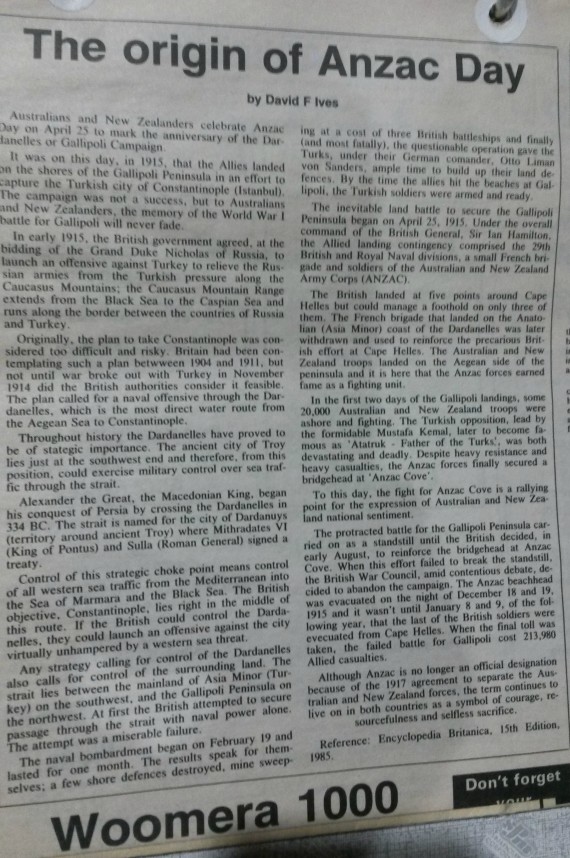
Many years ago, while stationed at Woomera, South Australia, as a member of the US Air Force, I wrote an article about ANZAC Day and it appeared in the local paper.
With ANZAC Day 2016 fast approaching, I thought it may be appropriate to dust it off and share it with any folks out there interested in the origin of one of the most important holidays on the Australian calendar.
***
Australian and New Zealanders celebrate ANZAC Day on April 25 to mark the anniversary of the Dardanelles or Gallipoli Campaign.
It was on this day, in 1915, that the Allies landed on the shores of the Gallipoli Peninsula in an effort to capture the Turkish city of Constantinople (Istanbul). The campaingn was not a success, but to Australians and New Zealanders, the memory of the Wold War I battle for Gallipoli will never fade.
In early 1915, the British government agreed, at the bidding of the Grand Duke Nicholas of Russia, to launch an offensive against Turkey to relieve the Russian armies from the Turkish pressure along the Caucasus Mountains; the Caucasus Mountain Range extends from the Black Sea to the Caspian Sea and runs along the boarder between the countries of Russia and Turkey.
Originally, the plan to take Constantinople was considered too difficult and risky. Britain had been contemplating such a plan between 1904 and 1911, but not until war broke out with Turkey in November 1914 did the British authorities consider it feasible. The plan called for a naval offensive through the Dardanelles, which is the most direct water route from the Aegean Sea to Constantinople.
Throughout history the Dardanelles have proved to be of strategic importance. The ancient city of Troy lies just at the southwest end and therefore, from this position, could exercise military control over sea traffic through the strait.
Alexander the Great, the Macedonian King, began his conquest of Persia by crossing the Dardanelles in 334 BC. The strait is named for the city of Dardanus (territory around ancient Troy) where Mithridates VI (King of Pontus) and Sulla (Roman General) signed a treaty.
Control of this strategic choke point means control of all western sea traffic from the Mediterranean into the Sea of Marmara and the Black Sea. The British objective, Constantinople, lies right in the middle of this route. If the British could control the Dardanelles, they could launch an offensive against the city virtually unhampered by a western sea threat.
Any strategy calling for control of the Dardanelles also calls for control of the surrounding land. The strait lies between the mainland of Asia Minor (Turkey) on the southwest, and he Gallipolli Peninsula on the northwest. At first the British attempted to secure passage through the strait with naval power alone. The attempt was a miserable failure.
The naval bombardment began on February 19 and lasted for one month. The results speak for themselves; a few shore defenses destroyed, mine sweeping at a cost of three British battleships and finally (and most faally), the questionable operation gave the Turks, under their German commander, Otto Liman Von Sanders, ample time to build up their land defenses. By the time the allies hit the beaches at Gallipoli, the Turkish soldiers were armed and ready.
The inevitable land battle to secure the Gallipoli Peninsula began on April 15, 1915. Under the overall command of the British General, Sir Ian Hamilton, the Allied landing contingency comprised the 29th British and Royal Naval divisions, a small French brigade and soldiers of the Australian and New Zealand Army Corps (ANZACs).
The British landed at five points around Cape Helles but could manage a foothold no only three of the them. The French brigade that landed on the Anatolian (Asia Minor) coast of the Dardanelles was later withdrawn and used to reinforce the precarious British effort at Cape Helles. The Australian and New Zealand troops landed on the Aegean side of the peninsula and it is here that the ANZAC forces earned fame as a fighting unit.
In the first two days of the Gallipoli landing, some 20,000 Australian and New Zealand troops were ashore and fighting. The Turkish opposition, lead by the formidable Mustafa Kemal, later to become famous as “Atatruk, – Father of the Turks,” was both devastating and deadly. Despite heavy resistance and heavy casualties, the ANZAC forces finally secured a bridgehead at “ANZAC Cove.”
To this day, the fight for ANZAC Cove is a rallying point for the expression of Australian And New Zealand national sentiment.
The protracted battle of the Gallipolli Peninsula carried on as a standstill until the British decided, in early August, to reinforce the bridgehead at ANZAC Cove. When this effort failed to break the standstill, the British War Council, amid contention debate, decided to abandon the campaign. The ANZAC beachhead was evacuated on the night of December 18 and 19, 1915 and it wasn’t until January 8 and 9, of the following year, that the last of the British soldiers were evacuated from Cape Helles. When the final toll was taken, the failed battle for Gallipoli cost 213,980 Allied casualties.
Although ANZAC is no longer an official designation because of the 1917 agreement to separate the Australian and New Zealand forces, the term continues to live on in both countries as a symbol of courage, resourcefulness and selfless sacrifice.
Reference: Encyclopedia Britannica, 15th edition 1985.
Hey, thanks for the forum.Really thank you! Utsler
You’re welcome William.
On 30 April 1915, when the first news of the landing reached New Zealand, a half-day holiday was declared and impromptu services were held.
Thanks!